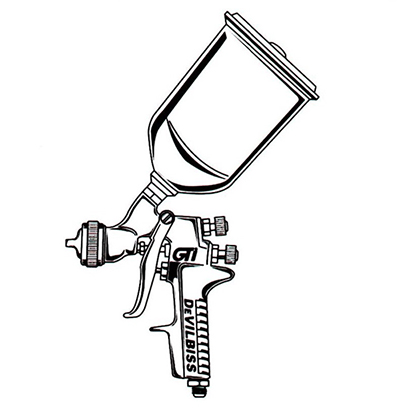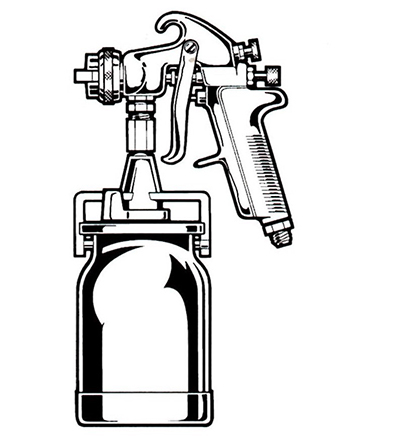Aircraft Painting for Fun and Relaxation Part 1
By Mike Davenport, EAA 89102, Langley, British Columbia
April 2017 - As previously mentioned in Bits and Pieces, contracting out the painting of your airplane can be an expensive business. This is because professional paint shops are in the business of making money. They have a lot of expenses to deal with – starting with the business license; the overhead of shop rental or ownership; materials, equipment and labour costs; hazardous waste disposal, as well as meeting of all the environmental issues that add to the cost of doing business. At the end of the day, they also need to make a profit in order to stay in business.
However, if you have built or restored your own aircraft, you have the will to finish it yourself. There is no mystery or magic involved, just more hard work. The feeling of satisfaction that comes from answering that question, “Who did your paint job?” with a resounding “I did” is the icing on the cake.

Gravity-fed spray guns are ideal for small applications such as spot repair, detail finishing, or finishing in a restricted space. They require less air than a suction-feed gun and produce less overspray.
I have painted cars and airplanes, cabinets and houses, but never professionally; instead I pursued a career in sales and management and learned to paint simply by doing it. I have painted in workshops, in hangars, and, yes, on occasion even in a real spray booth. Each presented its own challenges, but in the end I had a clean, shiny finish.

Suction-feed gun with attached cup.
The “secret” to a great paint job is … preparation, preparation, and, yes, more preparation!
Preparation starts early in the project. For example, don’t write or mark the surface with anything that can’t be washed off. Pen lines or marker ink bleeding through the primer and top coats can ruin your day. Oil on anything will cause fisheyes, as will waxes, mold releases, and the mayonnaise from your lunchtime sandwich.
A common excuse for not painting your project is what if I leave runs in it? There is no painter alive who has not “signed” his work with a run. An important thing to remember is that there is absolutely nothing you can do with a spray gun that can’t be fixed with sand paper. On a personal note, two painters, who must remain nameless, ran the paint off my fiberglass wingtips four times before they got it right.
In future columns, I will describe the painting of a typical aircraft from prep to finish top coat, wax and grease removers, use of primers and primer surfacers (yes Louise, they are different), the types and grits of sandpaper, wet versus dry sanding, masking tapes and papers, ventilation, and safety. We will also discuss various types of top coats. Your feedback will make this column more useful, so comments and questions requested.
The author had a 40-year career in the painting industry, working first for a major spray equipment manufacturer, an even larger paint manufacturer, and finally retired as an operations manager for a wood finishes distributor. He has painted a number of aircraft for his EAA chapter – a Pober Pixie, a J5 and a Turbi, his Q-2, and his ’46 Stinson. Metal aircraft painted include a Piper Arrow and a Luscombe 8E.
